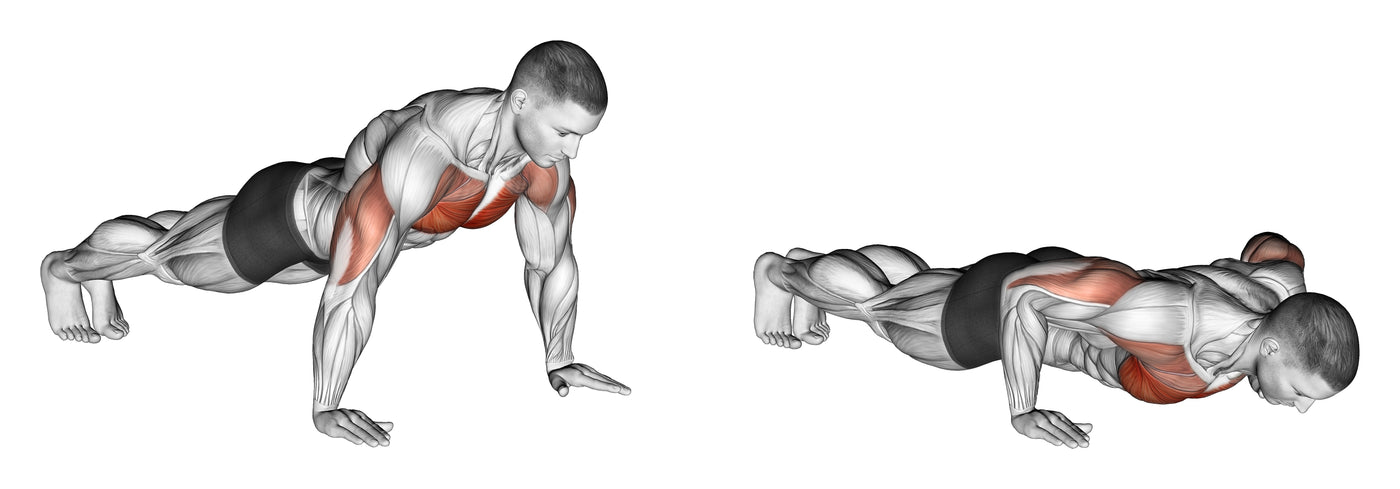Exercise Anatomy
Pushup
The push-up is a fundamental and highly effective bodyweight exercise that targets the chest, shoulders, triceps, and core. This versatile exercise requires no equipment and can be performed anywhere. Incorporating push-ups into your routine can build upper body strength, enhance muscular endurance, and contribute to overall fitness.

Major Muscles and Actions Involved
During the Push-up, the primary joint action is shoulder flexion and extension, as well as elbow extension. This dynamic movement engages several muscle groups, including the pectoralis major, deltoids, triceps brachii, serratus anterior, and various muscles in the core, such as the rectus abdominis and transverse abdominis. The coordinated effort of these muscles allows for a full-body workout, targeting the upper body and core simultaneously.

Sports Uses
The push-up is a foundational exercise with direct benefits for a wide range of sports and physical activities. In sports like basketball and volleyball, where upper body strength and explosiveness are essential for shooting, blocking, and spiking, the push-up proves invaluable. Wrestlers, martial artists, and athletes involved in combat sports benefit from the enhanced chest and triceps strength for effective pushing movements. Moreover, in disciplines such as gymnastics and calisthenics, where bodyweight strength is paramount, the push-up serves as a fundamental exercise to build and maintain upper body and core strength. Regardless of the sport, integrating push-ups into training regimens can improve overall upper body endurance, stability, and functional strength.
Exercise Tips
- Proper Form: Maintain a plank-like position with your body straight from head to heels. Ensure your hands are slightly wider than shoulder-width apart, and your elbows form a 90-degree angle when lowering your chest towards the ground. This promotes optimal muscle engagement and reduces the risk of strain.
- Full Range of Motion: Perform push-ups through a full range of motion, lowering your chest as close to the ground as possible without touching. This maximizes muscle activation, particularly in the chest and triceps.
- Controlled Movements: Execute push-ups with controlled movements, avoiding rapid or jerky motions. This emphasizes muscle contraction and minimizes the use of momentum, promoting better strength gains.
- Variations for Progression: Experiment with different push-up variations, such as diamond push-ups, wide grip, or decline push-ups, to target various muscle groups and add progression to your routine. Adjust the difficulty to match your fitness level.
- Breathing Coordination: Inhale as you lower your body towards the ground and exhale as you push back up. Maintain a steady and controlled breathing pattern to enhance oxygen flow to the muscles and support endurance during push-ups.
Pushups vs Bench Press
Push-ups and bench presses are upper body exercises that target similar muscle groups but differ in terms of mechanics and equipment. Push-ups are bodyweight exercises that primarily work the chest, shoulders, and triceps. They engage stabilizing muscles, including the core, and are versatile, suitable for various fitness levels. Push-ups also provide a functional, full-range-of-motion workout.
Bench presses, on the other hand, are typically performed with a barbell on a bench. This exercise allows for greater resistance, making it effective for building upper body strength, particularly in the chest, shoulders, and triceps. Bench presses also involve more equipment and are often part of weightlifting routines.
In summary, push-ups are bodyweight exercises that emphasize functional movement and engage stabilizing muscles, while bench presses involve external resistance, making them more conducive to heavy strength training. Both exercises contribute to upper body development but cater to different preferences and fitness goals.

Want To Learn More?
Try our premium ebook, Exercise Anatomy and Biomechanics: Ultimate Guide.
Satisfaction guaranteed.
